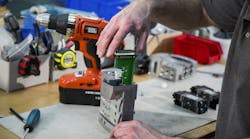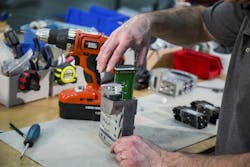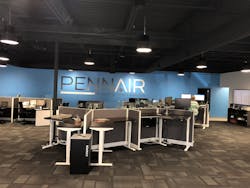Congratulations Hydraulics & Pneumatics—thriving through more than 70 years of change is a real accomplishment. At Penn-Air & Hydraulics Corp. (PennAir), we know something about longevity and change. We were founded 50 years ago amidst a disruptive period in the industry, and we are happy to celebrate our milestone anniversary as you celebrate yours.
Cheryl Rhein joined the family business 20 years after it was founded in 1968 by her parents; she now serves as CEO.
In 1968, my father, Jim Conrad, foreseeing changes at the company where he was a top salesman, set off and established his own distribution business in a small rented garage. I’ve learned that this was not an uncommon beginning among fluid power companies. My father was encouraged—even requested—to do so by the C.A. Norgren Co., now IMI Precision Engineering, which committed to supply him with Norgren products and support. That part is not so common.
PennAir founders Jim and Mary Conrad. The letter from Norgren that provided the impetus for Jim to found PennAir reads in part, “Jim Conrad, of course, has a most enviable sales record and I think it would be accurate to say he could have his pick of most any competitive distributor in the area.”
The industry grew, and so did we. In 1988, again with Norgren’s encouragement, we expanded our territory and I started my full-time job with the company, working with my husband, Bob Rhein (today’s president), who joined in 1986. In 2000, we bought our largest competitor. We went from 400 to 24,000 ft2 to our new space today, a 116,000-ft2 distribution and assembly facility, where we work with pneumatics, hydraulics, electro-mechanical products, and robots.
This facility reflects one of the biggest changes in modern distribution. We no longer simply stock and sell product—we are an engineering firm. We have a team of mechanical, electrical, and structural engineers on staff and employ experts in robotics and IT, all to help customers make machines and plants safer, more efficient, and more productive.
Today, for the first time in our history, we have as many associates aged 50-65 (two of our associates have been with us 42 years) as those 20-35 years old. The knowledge and experience of our seasoned employees is immeasurably valuable, as is the curiosity and innovation of our newer ones. The combination moves us from “we’ve always done it that way” to “what would happen if we tried it this way?”
This assemblage of experience, expertise, creativity, and innovation will carry us through our second 50 years. The next generation includes our COO (and son-in-law), Seth Bray. With a background in business and finance rather than fluid power, he brings a fresh perspective.
PennAir COO Seth Bray gets excited about IIoT and the future of automation in every facet of life. His generation will build PennAir’s next 50 years on giving customers real help and guidance in design and integration, not just stocking and supplying components.
Seth’s most exciting and optimistic insight is that automation is entering every facet of life now. Demand for goods and services—along with changing expectations for how they are ordered, purchased, and delivered—is creating new applications for motion control systems. For example, our components were traditionally sold to machine builders and manufacturing plants, but today we might sell to a server farm, a heating and cooling company, an automated retailer or restaurant, a car wash…customers who need to open a door, restock a shelf, or deliver a product.
Our future is helping them by designing and building subassemblies, installing systems, and integrating them into their workflow. Our growth will be in areas where people need real help and guidance. As Seth puts it, “We use online tools, but we’re not an online store. Customers are willing to buy the safety and security of knowing we’re backing up what we sell. When you’re buying thousands of dollars’ worth of equipment, you want to talk it through with someone before signing the check.”
Over the last 50 years, PennAir customers have come to expect skilled hands, experienced people, and continuous process improvements. Here, a senior assembly specialist assembles a high-tech Norgren valve manifold, one of over a thousand built to date. With a valve stack like this, OEMs can achieve multiple outputs with one common pneumatic supply and exhaust.
Seth predicts that the Industrial Internet of Things (IIOT) will be wildly important in these new markets. For us, it will be an opportunity to get much more done with less stress for our associates and our customers. The real impact will be when networks reach all the way from customer to distributor to manufacturer. For example, the network will tell us the condition of a customer’s component and let us alert the manufacturer when it’s time to build a replacement.
Our new facility is not like any distributor’s I’ve ever seen. Our warehouse feels like a laboratory and our open offices feel like a tech company, because that’s what we are. This helps us recruit—not on “categories,” but instead on the best fit, irrespective of age or appearance. And we are intentional about showing appreciation frequently.
PennAir’s new collaborative workspace feels more like a tech company than an old-style industrial distributor.
Our first 50 years were notable for advances in motion control technology. We expect our next 50 years to be marked by advances in technology that drive demand for motion control in ways we have yet to imagine.







